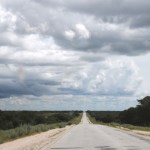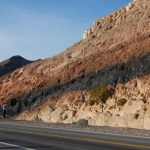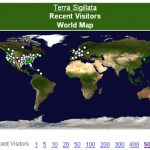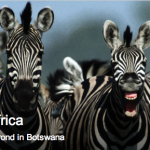Africa
tags: Kalahari Persistence Hunt, film making, marathon, kudu, Africa, BBC One, David Attenborough, streaming video
During a persistence hunt, an antelope, such as a kudu, is not shot or speared from a distance, but simply run down in the midday heat. Depending on the specific conditions, hunters of the central Kalahari will chase a kudu for about two to five hours over 25 to 35 km in temperatures of about 40 to 42°C (104 to 107°F). The hunter chases the kudu, which then runs away out of sight. By tracking it down at a fast running pace the hunter catches up with it before it has had enough…
Last year Neatorama's Alex Zavatone happened to find himself near Angola on the African continent. While driving through Grootfontein, Namibia, he spotted a road sign that simply said "Meteorite." Later he decided to make a 170 mile pilgrimage through beautiful and wild landscapes to Hoba to see what it was all about.
You'll have to go to the Neatorama website to see the money shot - but it's worth it! I've never seen such a well-presented interplanetary visitor. Read Alex's full tale here.
A leopard (Panthera pardus). Image from Wikipedia.
SK-54 is a curious fossil. The 1.5 million year old skullcap represents a juvenile Paranthropus robustus, one of the heavy-jawed hominins which lived in prehistoric South Africa, but there is something that makes this skull fragment particularly special. Near one of the sutures along the back of the skull are two neat puncture marks, the hallmark of a leopard.
Even though it was initially proposed that SK-54 had been murdered by another australopithecine wielding a weapon of bone or horn, in the late 1960's the paleontologist C.K. Brain…
CHAI RANT!!!11!!
It is time for another Chai Rant.
Years ago, about the twentieth word I learned in KiSwahili was "chai" ... which, if you know Kiswahili you would immediately recognize as a borrowed term becasue it is a very unlikely set of phonemes for that language. In KiSwahili, Chai means tea.
If I tell someone in the United States, for some reason, "In KiSwahili, 'chai' means 'tea'" the usual response will be "Oh, yea, I know that stuff. I like/don't like "chai." Chai is tea with cardamom and cinnamon and bla bla bla...."
And then I have to make the "shut up moron" clamy-clampy…
Spotted hyenas giggling over an antelope spine. Courtesy BMC Ecology.
For spotted hyenas, a laugh can speak volumes about an individual.
Despite being portrayed as stupid scavengers who rely on the leftovers of lion prides, hyenas are highly intelligent and social predators. They communicate with each other through an array of whoops, yowls, grunts, screams, and giggles, and by using these calls an individual can call in help to run lions off a carcass or signal that it's time to beat a hasty retreat if the odds don't look as favorable. Yet there is more to a hyena call than just its…
I'm still playing catch-up after my week in the desert, so I've seen a lot of articles I've wanted to mention ... but a certain other volcano has taken up a lot of my time. However, I will attempt to make amends for that now.
By the way, would you believe Ubehebe Crater was closed? How do they close a volcano, anyway? However, I did get a great snap of a welded tuff on the road outside of Shoshone, CA.
A strongly welded tuff near Shoshone, CA. The dark interior is remelted volcanic ash/tephra surrounded by less welded pink tuff with abundant pumice clasts. Denison student David Sisak is on…
The latest in my Volcano Profiles series, this one on Erta Ale in Ethiopia.
The summit crater at Erta Ale in 1994
Location: The Afar region of Ethiopia.
Height: 613 m / 2,011 feet
Tectonic setting: Erta Ale (meaning "smoking mountain") is part of the East African Rift, where the African Continent is tearing apart along a seam that runs from the Red Sea/Gulf of Aden (two other arms of the rift themselves) south through eastern Africa. Many of the large lakes of eastern Africa such as Lakes Albert, Tanganyika, Nyasa and Kariba fill rift valleys created by the cracking of the continental plate…
An adult chimpanzee in Bossou, Guinea uses hammer and anvil stones to crack nuts as younger individuals look on. From Haslam et al., 2009.
Before 1859 the idea that humans lived alongside the mammoths, ground sloths, and saber-toothed cats of the not-too-distant past was almost heretical. Not only was there no irrefutable evidence that our species stretched so far back in time, but the very notion that we could have survived alongside such imposing Pleistocene mammals strained credulity. Contrary to what might be immediately expected, however, it was not Darwin's famous abstract On the…
The flu has retreated and I'm getting back on track. Huzzah!
I'll get back to the blog by posting this week's new USGS / Smithsonian Institution Global Volcanism Program Weekly Volcano Report. Looks like some interesting stuff in it ...
Looks like there were some small eruptions from Oldoinyo Lengai in Tanzania. The volcano is one of the few (only active?) carbonatite volcanoes in the world, erupting a lava composed primarily of calcium carbonate and sodium minerals with very little silica. It leads to the odd lava that erupt black (and cool ~ 500C) and cool to white, making it one of the…
A half century of struggle has resulted in more than a little change, which we hope is still ongoing.
I was moderately disturbed to see, while watching a brand new documentary on human evolution, credit for the "discovery" of a particular fossil given to a man who had not in fact discovered the fossil. What was interesting about this mis-attribution is that a DIFFERENT guy who is also not the discoverer usually gets the credit. So, my first thought was "What were these two arguing about that led to this outcome, where the more powerful person got the credit?" and my second thought was "…
To the left I've juxtaposed the images of the four Bushmen males whose genomes were analyzed in the recent Nature paper and compared to Desmond Tutu. I've added to the montage a photo of a Swedish and Chinese man. The Nature paper looked at the HapMap data sets which had within them whites from Utah, northwest Europeans, and Chinese from Beijing, and compared these populations to the Bushmen and Desmond Tutu. One important point that this paper emphasized was that the rule-of-thumb that African populations have the most extant genetic diversity of all human groups, and that the Bushmen have…
What's wrong with this picture?:
You're looking at a screenshot of a map detailing the origins of each of the last 500 visits to Terra Sigillata. I took this shot at about 2 pm local time in Durban, South Africa, home to cognitive science blogger Michael Meadon at Ionian Enchantment. Michael is a graduate student at the University of KwaZulu-Natal and I learned about him via a Twitter referral - from whom I can't recall.
Be that as it may, last week Michael put out a call last week for "Africa's science nerds":
Africa, then, needs skeptical, reasoned, and scientific voices, not only to…
News!
Pakistan is home to the world's tallest mud volcano in the region of Balochistan - and its somewhat near the reports of an "eruption" earlier this week.
Guess what? Since Wednesday evening, seismicity at Yellowstone has dropped precipitously. The last batch of earthquakes on February 3rd were also back to deeper levels - 8-9 km depth - compared to the potential shallowing earlier in the week. I'm sure the caldera will keep us on our toes, but as of now, it seems to have settled down a bit.
Over in Pakistan, there is mounting evidence that the recent "volcanic" eruption reported as, in…
Highly Punctuated Patterns of Population Structure on the X Chromosome and Implications for African Evolutionary History:
It is well known that average levels of population structure are higher on the X chromosome compared to autosomes in humans. However, there have been surprisingly few analyses on the spatial distribution of population structure along the X chromosome. With publicly available data from the HapMap Project and Perlegen Sciences, we show a strikingly punctuated pattern of X chromosome population structure. Specifically, 87% of X-linked HapMap SNPs within the top 1% of FST…
Have you ever said to yourself, "Self, have you ever said to your self, 'What are African wild animals up to right now?'"
Now you can satisfy your self's overly demanding curiosity with National Geographic's WildCam. Don't worry, unlike most streaming webcam feeds, this is one you won't have to delete from your browser's history. The WildCam program is designed to inspire more talk about conservation by plopping viewers down right in the middle of the wild. Like, the real wild. Like, the no-messin-around-or-animals-gone-eat-you-up wild.
In an age where people are inundated with edited sound…
I was doing some exploring of the effect of a transition to agriculture on human height. Until the past few centuries humans were much shorter than they had been during the Ice Age. In the process I came upon some interesting data. Height, health, and development:
Adult height is determined by genetic potential and by net nutrition, the balance between food intake and the demands on it, including the demands of disease, most importantly during early childhood. Historians have made effective use of recorded heights to indicate living standards, in both health and income, for periods where…
Somehow I haven't posted a bunch of interesting items collected over the last few weeks, so I need to catch up. A pre-emptive hat tip to everyone who has sent me links or notes that might seem familiar in this post.
Tungurahua in Ecuador erupting in 2000.
First off, those of you looking for information on the Haitian earthquake that devastated the capitol Port Au Prince, Highly Allochthonous has post on the tectonics of the quake. Right now, it is hard for me to come up with a worse location in terms of devastation for a quake to have hit in the Caribbean Basin.
Back in volcano news, a lot…
Did you ever watch cattle? I mean, really watch them, for a few hours? Mostly they just sit or stand around munching on grass, chewing their cud, or snoozing. But every once in a while a handful of them will stand up and point in one direction. And they may take a few steps in that direction. Then a few more will join them. And once a critical mass has been reached, the whole herd will just go. Domestic cattle, wild African cape buffalo, whatever. This is what they do.
And as the cattle do, so do Scienceblogs.com bloggers. And the current stampede about to form up is about fitness. I'm…
tags: education, public outreach, SciCafe, science cafe, AMNH, American Museum of Natural History, NYC, streaming video
Who: Ichthyologist Melanie Stiassny
What: free public presentation, "Mysteries of the Congo: Exploring the World's Deepest River"
When: TONIGHT at 700pm
Where: Gottesman Hall of Planet Earth, American Museum of Natural History, Enter at the 81st Street (Rose Center) [directions and maps]
Cost: FREE, and there is a cash bar too! (must be 21+ with ID)
What strange new species lurk beneath? Join Museum Curator Melanie Stiassny, an ichthyologist who has been featured on The…
Two volcanoes down, two volcanoes up!
Fire fountain on Nyamuragira in the Congo, January 2010.
Down
Mayon
Activity at Mayon has continues to drop - although PHIVOLCS warns that an eruption could happen at any moment and without much warning. About a quarter of the evacuated families have no returned home since PHIVOLCS gave the OK to return home on January 2 - but Philippine officials are still on alert in case evacuations have to be reinstated.
Redoubt
The resurgent Redoubt is no long ... er ... resurging? AVO lowered the alert status to Green - meaning normal/background levels of activity…



